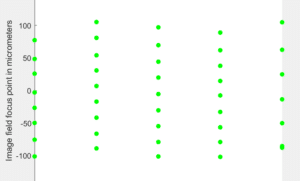This is a continuation of a series of posts on the Nikon D850. The series starts here. You should be able to find all the posts about that camera in the Category List on the right sidebar, below the Articles widget. There’s a drop-down menu there that you can use to get to all the posts in this series; just look for “D850”.
I realized that, armed with the code that I’d written for yesterday’s post, I could measure the step size of the Nikon D850’s Focus Shift Shooting (FSS) feature. I made a series of FSS exposures with the Nikon 105 mm f/1.4E lens with the step size set to 1, 2, 3, 4, and 5, and figured out the focus position in the image field, or, if you prefer, at the sensor plane.

This is a surprise. The steps seem to be about the same size for step sizes of 1 through 4, and that step size is about 25 micrometers. The step size starts growing only at the 5 setting. We know that the D850 takes into account the focal length of the lens, the distance to the target, and the lens aperture when it picks a step size. I have a SWAG about this, which I will test in the fullness of time, and that’s that the D850 won’t do steps smaller than 25 um, and only starts to make bigger ones when its algorithm comes up with a step that’s bigger than the minimum.
At f/1.4 a step size of 25 um from a perfectly focused starting place would yield a circle of confusion (CoC) of about 18 um. That would jibe with my earlier discovery that the minimum D850 FSS step size is too large for effective focus bracketing, but it also appears to be true that the minimum algorithmic step size — before clipping to the minimum hardware step size — is too large for that.
Leave a Reply